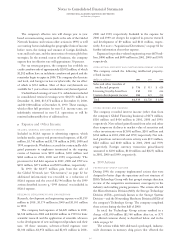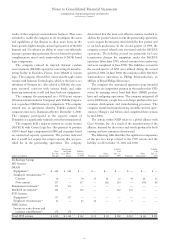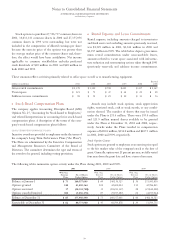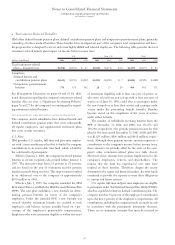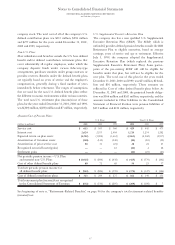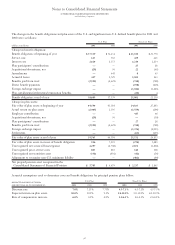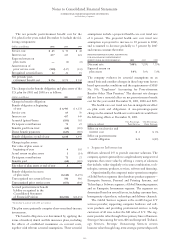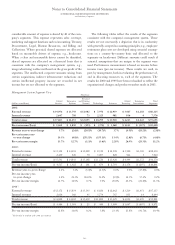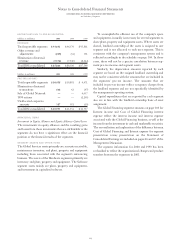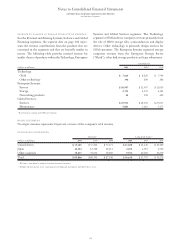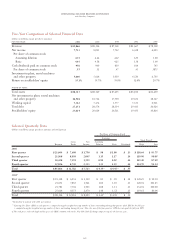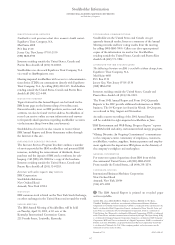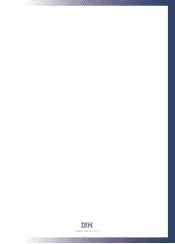IBM 2001 Annual Report Download - page 103
Download and view the complete annual report
Please find page 103 of the 2001 IBM annual report below. You can navigate through the pages in the report by either clicking on the pages listed below, or by using the keyword search tool below to find specific information within the annual report.
Notes to Consolidated Financial Statements
INTERNATIONAL BUSINESS MACHINES CORPORATION
and Subsidiary Companies
101
customers by taking on responsibility for their processes and
systems. BIS provides business/industry consulting and end-
to-end e-business implementation of such offerings as
Supply Chain Management, Customer Relationship
Management, Enterprise Resource Planning and Business
Intelligence. Integrated Technology Services offers cus-
tomers a single I/T partner to manage multivendor I/T
systems’ complexity in today’s e-business environment
including such traditional offerings as Product Support,
Business Recovery Services, Site and Connectivity Services,
and Systems Management and Networking Services.
Learning Services supports the three primary lines of busi-
ness and helps customers design, develop and deploy
curricula to educate their employees. The Global Services
segment is uniquely suited to integrate the full range of the
company’s and key industry participants’ capabilities, includ-
ing hardware, software, services and research.
The Enterprise Systems segment produces powerful
multipurpose computer servers that operate many open-
network-based applications simultaneously for multiple
users. They perform high-volume transaction processing
and serve data to personal systems and other end-user devices.
The servers are the engines behind the bulk of electronic
business transactions, including e-commerce. Brands include
the zSeries mainframe servers, the heart of the e-business
infrastructure for mission-critical data and transaction
processing, the pSeries servers, the most powerful techno-
logically advanced UNIX servers, the iSeries mid-range
servers, integrated mid-range business servers that run
sophisticated business applications and the Intel-based
xSeries servers. The segment also includes system-level
product businesses such as the company’s disk storage prod-
ucts, including the Enterprise Storage Server known as
“Shark,” tape subsystems and the company’s storage area
networking products.
In the first quarter of 2001, the company reorganized the
Personal Systems segment and renamed it the Personal and
Printing Systems segment. In accordance with the organiza-
tional change, the company transferred the Printing Systems
Division from the Technology segment to the Personal and
Printing Systems segment. In addition, the xSeries (Intel-
based) servers were transferred to the Enterprise Systems
segment from the Personal Systems segment. The Personal
and Printing Systems segment produces general-purpose
computer systems, advanced function printers, and point-of-
sale solutions. Major business units include Personal
Computers, Retail Store Solutions, and Printing Systems.
Major brands include ThinkPad mobile systems and NetVista.
The Technology segment provides components such
as semiconductors and HDDs for use in the company’s
products and for sale to original equipment manufacturers
(OEM). Major business units include Microelectronics and
Storage Technology.
The Software segment delivers operating systems for the
company’s servers and e-business enabling software (middle-
ware) for IBM and non-IBM platforms. The segment’s
business offerings align with key customer opportunity
areas
—
transformation and integration, leveraging informa-
tion, organizational effectiveness and managing technology.
In addition to its own development, product and marketing
effort, the segment supports 56,000 business partners to
ensure that the company’s software and hardware offerings
are included in their solutions.
The Global Financing segment is the world’s largest
provider of financing services for I/T. The segment provides
lease and loan financing that enables the company’s customers
to acquire complete I/T and e-business solutions
—
hardware,
software and services
—
provided by the company and its
business partners. Global Financing, as a reliable source of
capital for the distribution channel, also provides the com-
pany’s business partners with customized commercial
financing for inventory, accounts receivable and term loans,
helping them manage their cash flow, invest in infrastructure
and grow their business. Global Financing also selectively
participates in syndicated loan activities.
The Enterprise Investments segment provides industry-
specific I/T solutions, supporting the Hardware, Software
and Global Services segments of the company. The segment
develops unique products designed to meet specific market-
place requirements and to complement the company’s
overall portfolio of products. Enterprise Investments revenue
is primarily derived from the sale of software products.
Segment revenue and pre-tax income include transactions
between the segments that are intended to reflect an arm’s-
length transfer price. Specifically, semiconductors and
HDDs are sourced internally from the Technology segment
for use in the manufacture of the Enterprise Systems segment
and Personal and Printing Systems segment products. In
addition, technology, hardware and software that are used by
the Global Services segment in outsourcing engagements are
mostly sourced internally from the Enterprise Systems,
Personal and Printing Systems and Software segments. For
the internal use of I/T services, the Global Services segment
recovers cost, as well as a reasonable fee reflecting the arm’s-
length value of providing the services. The Global Services
segment enters into arm’s-length leases at prices equivalent
to market rates with the Global Financing segment to
facilitate the acquisition of equipment used in outsourcing
engagements. Generally, all internal transaction prices are
reviewed and reset annually if appropriate.
The company uses shared-resources concepts to realize
economies of scale and efficient use of resources. Thus, a


